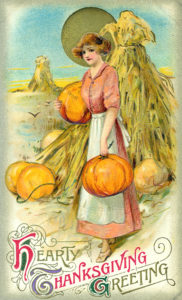We are on the fast approach to Thanksgiving, a moveable feast, and with it this year come two saints’ days worthy of note: St. Cecilia’s Day on Thanksgiving Day itself, the 22nd of November, and St. Clement’s Day the next day, the 23rd. St. Cecilia is noteworthy as she is a patron saint of musicians and so her day is a fine one to enjoy their labor. In fact, concerts in honor of St. Cecilia on her feast day go back to at least 1570 in France.
As for Old Clem, he is a patron saint of blacksmiths and metal workers. In days when there were more smiths at work, the night of his feast day was a night when they would gather and drink and process about town, stopping at all the pubs. At some point, one of their number, who was dressed as St. Clement, would arise and deliver the following lines:
I am the real St. Clement, the first founder of brass, iron, and steel, from the ore. I have been to Mount Etna, where the god Vulcan first built his forge, and forged the armour and thunderbolts for the god Jupiter. I have been through the deserts of Arabia; through Asia, Africa, and America; through the city of Pongrove; through the town of Jipmingo; and all the northern parts of Scotland. I arrived in London on the twenty-third of November, and came down to Her Majesty’s dockyard at Woolwich, to see how all the gentleman Vulcans came on there. I found them all hard at work, and wish to leave them on the twenty-fourth.
Another in the party then adds:
Come, all you Vulcans stout and strong,
Unto St. Clem we do belong.
I know this house is well prepared
With plenty of money and good strong beer;
And we must drink before we part,
All for to cheer each merry heart.
Come, all you Vulcans, strong and stout,
Unto St Clem I pray turn out;
For now St Clem’s going round the town:
His coach and six goes merrily round.
It is a day when children would go “Clementing”––knocking on doors, singing rhymes in exchange for treats like oranges and apples. Rhymes like this one:
Oranges and lemons,
Say the bells of St. Clement’s.
You owe me five farthings,
Say the bells of St. Martin’s.
As I mentioned in the Convivio Dispatch for Halloween (if you didn’t get it in your email box and would like it, let me know and I’ll send it your way, for the Convivio Dispatch is something different from the Convivio Book of Days blog), my mother does not remember trick or treating at Halloween so much as she remembers doing something like it at Thanksgiving. She is Brooklyn born and bred, and there is an old New York Thanksgiving tradition known as the Ragamuffin Parade (though the name was news to her when I told her about it recently). It was popular at the turn of the last century, and began fading away by the mid 1900s. Kids would dress as ragamuffins and knock on doors, asking, “Something for Thanksgiving?”
Such interesting days, these days of late November. Thanksgiving always falls around my grandpa’s birthday, who was born way back in 1895. It was a birthday we celebrated each year on the 23rd, even though we learned later that Grandpa’s birthday may have been the 21st. It was on a Thanksgiving night, too, that my dad was visited by the ghost of his mother (which is another story that came up in that same Convivio Dispatch for Halloween). Perhaps it is this combination of ghostly stories and Mom’s Thanksgiving variation of trick or treating that always has me thinking of Thanksgiving as an extension of the autumnal days when we remember our dead. But Thanksgiving is a bit like that, no? We gather together, we share a fine meal, and for those of us who have been on this constantly rotating planet a good many years, we remember folks who have come and gone, stories that were told ages ago, and we get a bit wistful. And there is nothing wrong with that. These are all good things to be thankful for.
It is, by the way, a good time to order Advent candles and calendars from our Convivio Book of Days Catalog! Especially if you feel a bit rushed by Christmas (Why are there wreaths hanging on the doors of Lake Worth City Hall even before Thanksgiving?), a simple thing like an Advent candle that you light each night or an Advent calendar that you open a door on each day can really help bring some perspective to things. Ours are the traditional kinds: a few of our Advent calendars are made in England, but most are made in Germany, where the tradition began. And the daily Advent candles are made in England. We light ours each night at dinner. It’s part of what we call the Slow Christmas Movement. And we offer free domestic shipping when you spend $50!
Image: “Hearty Thanksgiving Greeting.” Chromolithograph postcard by John Winsch, 1910. Missouri History Museum Photographs and Prints Collections. Postcards. [Public domain, via Wikimedia Commons.]
